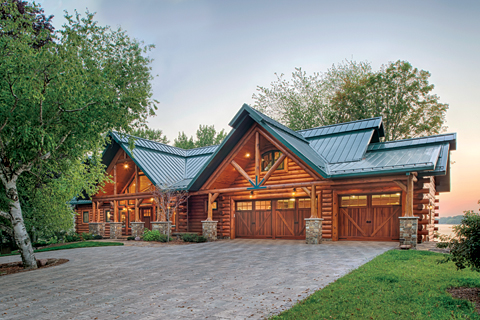The ravages of time take their toll on the exterior of a log or timber home. Although the wear of weather and climate are inevitable, finding the appropriate stain and finish combination preserves and protects the integrity of exposed wood surfaces while maintaining the good look that is so essential to the enjoyment of the home.
Choosing the right stain and finish involves an assessment of several factors, including climate, weather pattern, manufacturer warranties, application, and pricing. Sorting through these particulars may be challenging, but an appropriate investment on the front end prevents anxiety in the future.
“There are many good products on the market today, so I would suggest that you use a product with a proven track record,” advises Brad Neu of Montana Log Homes. “Many of our clients today are opting for a system of two coats of stain followed by a clear top coat. This allows for a wide variety of stain color choices and perhaps a little simpler follow-up maintenance. The clear top coat is designed to take the abuse of the sun and weather, so when it breaks down just a good cleaning and then spraying on a new clear top coat are all that is required.”
Tony Huddleston, vice president of sales and operations at Perma-Chink Systems, Inc., stresses performance, noting that some water-based products perform no better than the poorest quality oil-based stains. “When we talk about performance, what exactly do we mean?” he asks. “From a technical perspective we discuss terms like vapor permeability, adhesion, and UV resistance, but to a homeowner performance comes down to how long it will be before the finish looks so bad that it has to be reapplied. We all know that it is impossible to give a definitive answer to this question since so much depends on environmental factors.”
Developing a list of priorities makes the process of choosing a stain or finish easier. Consider the external factors and the properties of various products and come up with the best solution for your personal log or timber home. “Start with a list of your personal criteria,” relates Barbara Murray, president of CTA Products Group, “and list them in order of importance. Some criteria could be very specific such as a certain color or shade, while the product must be easy to apply, have a sleek and shiny finish, have a natural look, offer termite and rot control, prevent water infiltration, and more. Rank your criteria and start reading the product labels to see which one most closely matches your particular requirements.”
A healthy awareness of the gimmicks that are out there is beneficial as well. Simply put, if a statement or promise sounds too good to be true, it probably is. Be on the lookout for obvious warning signs, and remember that the lowest cost product may be the source of the biggest future headache.
“Avoid the cheapest stain you can find,” comments Huddleston. “The old saying, ‘You get what you pay for,’ is mostly true. Check out the coverage rates as advertised by the stain manufacturer since they vary greatly and what you save on less expensive finishes may end up actually costing more because it may take much more than expected.”
Stay away from homemade versions of stain and finish products as well. Many ingredients in such products are hazardous and difficult to handle. Check the MSDA (material safety data sheet) from the manufacturer and look for the health and safety section to see what hazards may be involved. Be wary of slogans that include words like “lifetime” or “maintenance free,” and take the time to read any accompanying warranty to determine what is covered and how difficult it may be to file a claim if that becomes necessary.
Ongoing maintenance and upkeep vary little from new construction to the reapplication of stains and finishes on an existing log or timber home. In either case, the homeowner’s vigilance is critically important.
“With new construction you do have the option of several different products and color choices,” explains Neu. “Ultimately that decision will limit your maintenance choices due to compatibility issues from one product to another. My advice is to choose your product from a reputable company and follow their recommendations for application. Then do follow-up maintenance as needed. People run into expensive maintenance when they postpone routine maintenance too long—when the initial product breaks down to a point where it must all be removed before a new product can be applied.”
Choosing quality stains and finishes and then keeping a close eye on the exterior of the log or timber home will minimize maintenance costs and allow you to extend the life of your investment while saving money and exhibiting pride of ownership.

